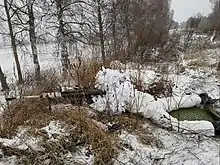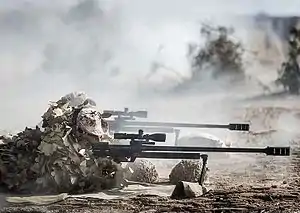Ghillie suit
A ghillie suit is a type of camouflage clothing designed to resemble the background environment - such as foliage, snow or sand. Typically, it is a net or cloth garment covered in loose strips of burlap (hessian), cloth, or twine, sometimes made to look like leaves and twigs, and optionally augmented with scraps of foliage from the area.


Military personnel, police, hunters, and nature photographers may wear a ghillie suit to blend into their surroundings and to conceal themselves from enemies or targets.[1] The suit gives the wearer's outline a three-dimensional breakup, rather than a linear one. When manufactured correctly, the suit will move in the wind in the same way as surrounding foliage. Some ghillie suits are made with light and breathable material that allows a person to wear a shirt underneath.

Russian hunters and soldiers may use ghillie suits with designs named for rural folk-spirits: the kikimora of the swamps or the leshy of the forests.[2]
History
The English word ghillie is derived from the Scots Gaelic gille, meaning a young man or older boy who works as an outdoor servant, and is most familiar in reference to those employed to assist sportsmen with recreational shooting or fishing in the Highlands. The term ghillie suit may be a reference to the Ghillie Dhu ('black-haired youth' or 'dark-haired lad'), an earth spirit clothed in leaves and moss in Scottish mythology.[1]
The Lovat Scouts, a Scottish Highland regiment formed by Simon Fraser, 14th Lord Lovat during the Second Boer War, is the first known military unit to use ghillie suits and in 1916 went on to become the British Army's first sniper unit.[3][4] The Lovat Scouts were initially recruited from Scottish Highland estate workers, especially professional stalkers and gamekeepers.[5]
Similar sniper outfits in the Australian Army are nicknamed yowie suit, named for their resemblance to the yowie, a mythical hominid similar to the yeti and bigfoot which is said to live in the Australian wilderness.[6]
Technical and safety considerations
Although highly effective, conventional ghillie suits (made in fabric or 3D leafsuits) are impractical for many situations where camouflage is useful. They tend to be very heavy and hot. Even in moderate climates, the temperature inside the ghillie suit can reach over 50 °C (122 °F). The burlap is also flammable, unless treated with fire retardant, so the wearer may be at increased risk from ignition sources such as smoke grenades or white phosphorus. Moreover, conventional ghillie suits and 3D leafsuits are made using fabric, so they retain water, and this dramatically increases weight. Conventional ghillie suits are not designed to camouflage in the IR spectrum, so they are highly detectable using night vision devices. Fabric strips, especially of coarse material like burlap, readily snag on thorns, twigs, and barb wire.
To enhance safety, the US Army Soldier Systems Center has developed an inherently fire-resistant, self extinguishing fabric to replace jute or burlap. This material was field tested in late 2007 at the Sniper School at Fort Benning and has been standard issue since June 2008.
Ghillie suits also have disadvantages in cold environments, as they can get soaked, risking hypothermia.[7]
Criminal use
Civilians have, on rare occasions, purchased ghillie suits to commit crimes (other than unlawful hunting). Police arrested an Australian man after they found that he had assaulted women while wearing such a suit.[8]
References
- David Amerland (2017), The Sniper Mind: Eliminate Fear, Deal with Uncertainty, and Make Better Decisions, St. Martin's Press, p. 53, ISBN 978-1-250-11368-9
- Gusev, Ilya Valer'yevich (14 May 2022) [2017]. The Great Encyclopedia of Hunting Большая энциклопедия охоты [Bol'shaya entsiklopediya okhoty] (in Russian). Moscow: AST. ISBN 9785457964327. Retrieved 28 August 2023.
Кому-то больше нравится расцветка «под камуфляж», а кому-то халаты типа «кикимора» или «леший». Каждый из вариантов по-своему хорош и удобен в определенных условиях.
- Pegler, Martin (2004). Out of Nowhere: A History of the Military Sniper. Osprey Publishing. ISBN 978-0-87364-704-5.
- Plaster, John (2006). The Ultimate Sniper: An Advanced Training Manual For Military And Police Snipers. Paladin Press. p. 5. ISBN 978-0-87364-704-5.
- Pegler (2004), S. 129
- Hogben, Bruce (17 June 1989). "Aussie ingenuity keeps our soldiers safely out of sight". The Advertiser. Adelaide, Australia.
- Wabo, Corporal (15 April 2021). "How to Make a Ghillie Suit from Scratch Like a Marine Sniper (with Camouflage Tips)". Marine Approved.
- "Central Coast father to face court over schoolgirl's assault". Yahoo! News Australia. 2017-08-27. Retrieved 2018-01-31.
Further reading
External links
 Media related to Ghillie suits at Wikimedia Commons
Media related to Ghillie suits at Wikimedia Commons
.jpg.webp)